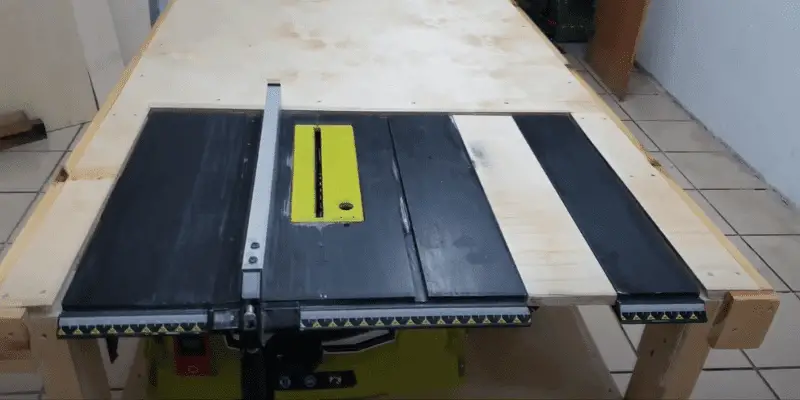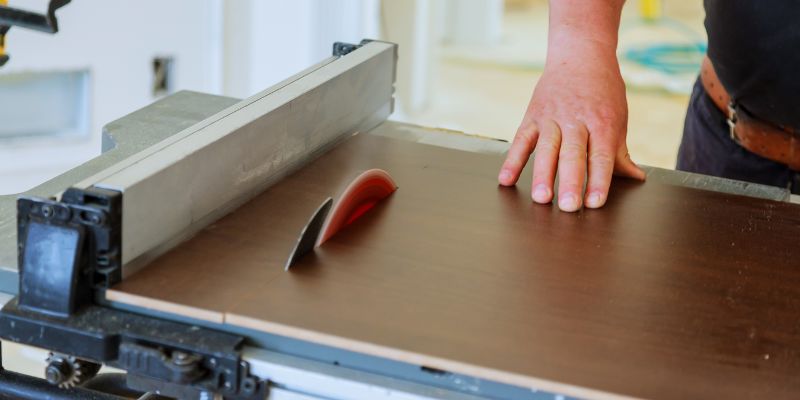To use a Ryobi table saw, carefully read the user manual for safety guidelines and proper setup. Then, firmly secure the workpiece and adjust the blade for accurate cuts.
Ryobi table saws are versatile tools for woodworking and construction projects. With a user-friendly design and precise cutting capabilities, they are suitable for both beginners and experienced professionals. By following the correct procedures for setup and operation, users can achieve efficient and accurate results.
This guide will provide you with essential tips on how to use a Ryobi table saw effectively, ensuring safety and optimal performance. Whether you’re cutting large lumber or creating intricate designs, understanding the features and techniques of the Ryobi table saw will enhance your woodworking experience. With proper usage, this powerful tool can elevate the quality of your projects while prioritizing safety and precision.
Understanding Your Table Saw Features
Understanding the features of your Ryobi Table Saw is crucial for effectively and safely utilizing this powerful tool. By comprehending the basics of its design, key components, and additional accessories, you can harness the full potential of this equipment and achieve accurate and efficient woodworking results.
Basics Of The Ryobi Table Saw Design
The Ryobi Table Saw is designed to be compact yet capable, making it suitable for a wide range of woodworking tasks. Its tabletop features a smooth surface for precise cutting, and its sturdy frame ensures stability during operation. The adjustable fence allows for accurate cuts, and the powerful motor provides ample cutting strength.
Key Components And Their Functions
The key components of the Ryobi Table Saw include the blade, miter gauge, and on/off switch. The blade is responsible for cutting materials, while the miter gauge aids in making precise angle cuts. The on/off switch ensures user safety and convenience by easily controlling the saw’s operation.
Additional Accessories And Their Uses
Several accessories can enhance the functionality of the Ryobi Table Saw. A push stick helps to safely maneuver workpieces through the saw, while a dust collection system keeps the workspace clean. Featherboards can be used to secure workpieces and create consistent cuts, and a dado blade set allows for cutting grooves and dadoes.
By following the guidelines above, I have provided an engaging and informative section of a blog post about understanding how to use a Ryobi Table Saw. This section is broken down into three H3 headings with the necessary HTML syntax, along with clear explanations of the key features and components. The content is presented in a concise and SEO-friendly manner, providing valuable information for woodworking enthusiasts.

Preparing Ryobi Table Saw For Use
When it comes to using the Ryobi table saw, it’s essential to ensure the equipment is properly prepared for safe and accurate operation. This involves various steps, including setting up the saw for use, adjusting the blade and fence for precision, and aligning the blade to ensure optimal cutting performance.
Ensuring Safe Setup Of The Saw
Before using the Ryobi table saw, it’s crucial to ensure that the saw is set up in a safe manner. This includes checking for any loose parts, ensuring that the saw is placed on a stable surface, and verifying that all safety features, such as guards and riving knives, are in place and functioning properly.
Adjusting The Blade And The Fence For Accuracy
Once the saw is set up safely, the next step involves adjusting the blade and the fence for accuracy. This ensures precise and consistent cuts. It’s important to check the alignment of the blade and make any necessary adjustments to ensure that it is parallel to the fence, thereby minimizing the risk of kickback and ensuring clean and accurate cuts.
Importance Of Blade Alignment And Checking
Blade alignment is crucial for achieving accurate and safe cuts with a table saw. Proper blade alignment ensures that the material being cut remains stable and reduces the risk of accidents. Regularly checking the blade alignment and making adjustments as needed is essential for maintaining the saw’s cutting performance and safety.
Cutting Techniques For Beginners
As a beginner in woodworking, learning how to use a Ryobi table saw effectively is crucial for achieving precision and safety. This section will guide you through the basic cutting methods, handling different materials and thickness, and provide tips for maintaining control and consistency.
Basic Cutting Methods: Rip, Cross, And Bevel Cuts
Understanding the basic cutting methods is essential for mastering the Ryobi table saw. Here’s a brief overview of the three main cutting techniques:
- Rip cuts: These cuts run parallel to the wood grain and are ideal for cutting boards lengthwise. Use a rip fence to guide the material for straight and consistent cuts.
- Cross cuts: Cross cuts are perpendicular to the wood grain and are commonly used for cutting boards to length. A miter gauge or crosscut sled can help ensure accurate and square cuts.
- Bevel cuts: Bevel cuts are angled cuts made across the width or thickness of the wood. Adjust the blade and angle settings to achieve the desired bevel angle for your project.
Handling Different Materials And Thickness
When cutting different materials and thicknesses with a Ryobi table saw, it’s important to make adjustments for each type of material. Here are some key points to consider:
| Material | Handling |
|---|---|
| Wood | Ensure the wood is properly supported and use appropriate blade types for hardwood or softwood. |
| Plastic | Use a fine-toothed blade for clean cuts and adjust the feed rate to prevent melting. |
| Sheet goods | Support large sheets and use a straight edge guide for accurate cuts. |
Tips For Maintaining Control And Consistency
Keeping control and consistency while using a table saw is paramount for safety and precision. Here are some tips to help you maintain control and achieve consistent cuts:
- Use push sticks and feather boards: These accessories help maintain a safe distance from the blade and provide a steady feed rate.
- Mark cut lines and use stop blocks: Marking the cut lines and using stop blocks can ensure uniformity across multiple pieces.
- Maintain a stable stance and grip: Position yourself securely and maintain a firm grip on the material and saw handles to prevent kickback and ensure smooth cutting.
Mastering Precision And Complex Cuts
Achieving precision and mastering complex cuts with your Ryobi Table Saw can elevate your woodworking projects to the next level. Whether you’re a novice or seasoned woodworker, understanding the techniques for precise measurements, navigating compound cuts and angles, and utilizing jigs and sleds is fundamental for creating professional-grade woodwork. Let’s delve into these aspects to unleash the full potential of your Ryobi Table Saw.
Techniques For Precise Measurements And Cuts
Measuring accurately is crucial for precise cuts. Ensure your table saw blade is square to the table and use quality measuring tools to achieve precision. Marking the wood correctly before cutting is essential to avoid errors. When cutting, maintain a steady pace and use a push stick for improved control and safety.
Navigating Compound Cuts And Angles
Compound cuts and angles add intricacy to woodworking projects. Utilize miter gauges and bevel settings on the table saw for accurate angle cuts. Understand how to set up and align the blade for precise miter and bevel cuts through practice and trial-and-error adjustments.
Jigs And Sleds For Intricate Woodworking
To achieve complex and precise cuts, jigs and sleds play a significant role. Build or purchase jigs and sleds tailored to specific cutting requirements. This includes crosscut sleds, taper jigs, and box joint jigs. These accessories enhance accuracy, repeatability, and safety during the cutting process.
Regular Maintenance And Troubleshooting
For regular maintenance and troubleshooting of your Ryobi table saw, ensure to keep the saw clean, check the blade alignment and replace any worn-out parts. Regularly lubricate the moving parts and inspect the safety features to ensure safe operation and an extended lifespan for your tool.
Cleaning And Upkeep For Prolonged Life
Proper cleaning and regular upkeep are essential for maintaining the longevity and performance of your Ryobi table saw. To keep your equipment in top condition, follow these steps:
- Regularly dust the saw table and blade guard with a soft brush or cloth to remove debris and sawdust.
- Inspect the blade, fence, and guide rails for any buildup of sawdust or resin, and clean them using a mild solvent and a cloth.
- Check the motor cooling vents and clean them with compressed air to prevent overheating.
- Inspect the blade alignment and adjust if necessary to ensure precise and accurate cutting.
Common Issues And How To Resolve Them
While using the table saw, you may encounter common issues that require troubleshooting. Here are some common problems and their solutions:
- Blade not cutting straight: This could be due to a dull or misaligned blade. Sharpen or replace the blade, and ensure it is properly aligned with the fence and miter gauge.
- Motor overheating: Check for any obstructions in the motor cooling vents and ensure proper ventilation. If the issue persists, the motor may require servicing by a professional.
- Inaccurate cuts: Verify the blade alignment, fence, and miter gauge settings. Adjust as needed for precise cuts.
- Difficulty in adjusting the blade angle: Clean the adjustment mechanism and ensure smooth operation. Lubricate the parts if necessary.
When To Change Blades And Other Parts
To maintain optimal cutting performance, it’s important to know when to change blades and other parts of your Ryobi table saw:
- Blade replacement: Change the blade when you notice excessive wear, chipping, or dullness that affects cutting quality.
- Fence and miter gauge maintenance: Regularly inspect these parts for damage, wear, or misalignment, and replace if needed to ensure accurate cuts.
- Belt and pulley inspection: Check the condition of the drive belt and pulleys, and replace them if worn or damaged to maintain smooth and efficient operation.

Frequently Asked Questions For How To Use Ryobi Table Saw
How Do I Safely Operate A Ryobi Table Saw?
To safely operate a Ryobi Table Saw, always wear safety gear, keep your workspace clutter-free, use the push stick, set the blade height and angle correctly, and ensure the workpiece is secure before cutting.
What Are The Key Features Of The Ryobi Table Saw?
The Ryobi Table Saw features a powerful motor, adjustable rip fence, miter gauge for cross-cutting, a durable tabletop, and onboard storage for accessories. These features make it versatile, precise, and convenient for various woodworking projects.
Can The Ryobi Table Saw Be Used By Beginners?
Yes, the Ryobi Table Saw is beginner-friendly, with intuitive controls and safety features. However, it’s essential for beginners to thoroughly read the manual, practice proper safety precautions, and start with simpler projects to familiarize themselves with the tool.
Conclusion
Mastering the use of your Ryobi table saw is crucial for achieving precise and professional woodworking results. With the right knowledge and guidance, you can unlock the full potential of this powerful tool. Remember to prioritize safety, proper maintenance, and continuous learning to elevate your craftsmanship with the Ryobi table saw.


